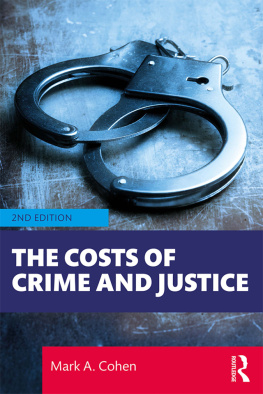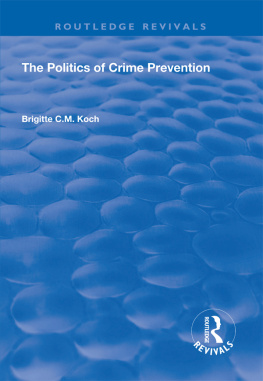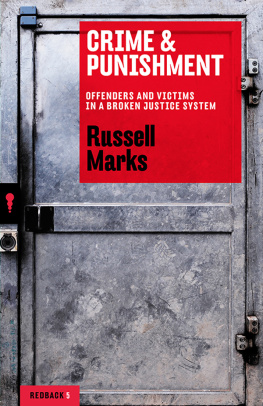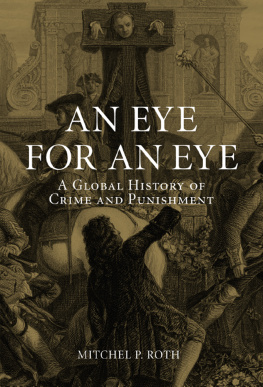THE COSTS OF CRIME AND JUSTICE
This book presents a comprehensive view of the financial and non-financial consequences of criminal behavior, crime prevention, and societys response to crime. Crime costs are far-reaching, including medical costs, lost wages, property damage and pain, suffering, and reduced quality of life for victims and the public at large; police, courts, and prisons; and offenders and their families who may suffer consequences incidental to any punishment they receive for committing crime.
The book provides a comprehensive economic framework and overview of the empirical methodologies used to estimate costs of crime. It provides an assessment of what is known and where the gaps in knowledge are in understanding the costs and consequences of crime. Individual chapters focus on victims, governments, as well as the public at large. Separate chapters detail the various methodologies used to estimate crime costs, while two chapters are devoted to policy analysis both cost-effectiveness and benefit-cost analysis. The second edition is completely updated and expanded since the first edition in 2005. All cost estimates have also been updated. In addition, due to a significant increase in the number of studies on the cost of crime, new chapters focus on the costs to offenders and their families; white-collar and corporate crime; and the cost of crime estimates around the world.
Understanding the costs of crime can lead to important insights and policy conclusions both for criminal justice policy and other social ills that compete with crime for government funding. Thus, the target audience for this book includes criminologists and policy makers who are seeking to apply rigorous social science methods to assist in developing appropriate criminal justice policies. Note that the book is non-technical and does not assume the reader is conversant in economics or statistics.
Mark A. Cohen holds the Justin Potter Chair in American Competitive Enterprise at the Owen Graduate School of Management, Vanderbilt University, and also holds a secondary appointment as Professor of Law at Vanderbilt. He was previously a Visiting Professor of Criminal Justice Economics at the University of York, UK, and Chairman of the American Statistical Associations Committee on Law and Justice Statistics. Professor Cohen received his PhD in Economics from Carnegie Mellon University. He is the author of more than 100 books and journal articles on crime, law, and economics.
THE COSTS OF CRIME AND JUSTICE
Second Edition
Mark A. Cohen
Second edition published 2020
by Routledge
2 Park Square, Milton Park, Abingdon, Oxon, OX14 4RN
and by Routledge
52 Vanderbilt Avenue, New York, NY 10017
Routledge is an imprint of the Taylor & Francis Group, an informa business
2020 Mark A. Cohen
The right of Mark A. Cohen to be identified as author of this work has been asserted by him in accordance with sections 77 and 78 of the Copyright, Designs and Patents Act 1988.
All rights reserved. No part of this book may be reprinted or reproduced or utilised in any form or by any electronic, mechanical, or other means, now known or hereafter invented, including photocopying and recording, or in any information storage or retrieval system, without permission in writing from the publishers.
Trademark notice: Product or corporate names may be trademarks or registered trademarks, and are used only for identification and explanation without intent to infringe.
First edition published by Routledge 2005
British Library Cataloguing-in-Publication Data
A catalogue record for this book is available from the British Library
Library of Congress Cataloging-in-Publication Data
Names: Cohen, Mark A., author.
Title: The costs of crime and justice / Mark A. Cohen.
Description: Second edition. | Abingdon, Oxon; New York, NY:
Routledge, 2020. | Includes bibliographical references and index.
Identifiers: LCCN 2019049469 (print) | LCCN 2019049470 (ebook)
Subjects: LCSH: CrimeEconomic aspects. |
Criminal justice, Administration ofEconomic aspects.
Classification: LCC HV6171 .C64 2020 (print) | LCC HV6171 (ebook) |
DDC 364dc23
LC record available at https://lccn.loc.gov/2019049469
LC ebook record available at https://lccn.loc.gov/2019049470
ISBN: 978-1-138-36364-9 (hbk)
ISBN: 978-1-138-36366-3 (pbk)
ISBN: 978-0-429-43156-2 (ebk)
Typeset in Bembo
by Apex CoVantage, LLC
To Robin who taught me to value what is most important in life...
CONTENTS
- PART I
Introduction - PART II
Bottom-up estimates of the cost of crime and justice - PART III
Methodologies for estimating the cost of crime - PART IV
Policy analysis of crime control and prevention programs - PART V
Special topics in the cost of crime and justice
- PART I
Introduction - PART II
Bottom-up estimates of the cost of crime and justice - PART III
Methodologies for estimating the cost of crime - PART IV
Policy analysis of crime control and prevention programs - PART V
Special topics in the cost of crime and justice
Guide
This book is a culmination of 35 years of sporadic journeys into estimating the costs of crime and justice. My travels began rather serendipitously as I never studied crime in college or graduate school. I am an economist trained to analyze the allocation of resources in society. My dissertation was concerned with the optimal enforcement policy to reduce oil spills and I adapted the Gary Becker (1968) model of the economics of crime to analyze government penalties and enforcement policies designed to prevent oil spills from tankers and to conduct a benefit-cost analysis of the governments policy. In 1985, when the newly established United States Sentencing Commission was in the process of being formed, I received a phone call from Professor Michael Block at the University of Arizona. Professor Block was one of the few economists who specialized in analyzing crime issues. He had just been appointed by President Reagan to be a commissioner of the new Sentencing Commission and was looking for a young economist who knew something about the economics of crime. I told him that I was not his man, since I knew nothing about crime. That did not seem to matter to him being a well-trained economist was more important to him than substantive knowledge about crime. Thus, my journey began.
The first few days on the job were fascinating. I was literally the first staff member to arrive at the Commission other than a few administrative staff. I sat around the table with eight commissioners including several judges one of whom, Stephen Breyer, would later be appointed to the Supreme Court. The Commissioners turned to me and asked if I could do some research and brief them on (a) how social scientists have ranked the severity of crime, and (b) what is known about the factors that judges use to sentence offenders. While I worked on both issues over the next several months, the first question was most intriguing. I found a vast literature beginning with Sellin and Wolfgangs (1966) path-breaking public perception surveys used to rank crime severity. While these methods are valuable and have withstood the test of time the economist in me asked if there was a more objective way to rank crime severity the actual harm caused by crime. Thus, I began to look for any study that placed dollar values on crime with the ultimate goal of being able to conduct benefit-cost analyses.








